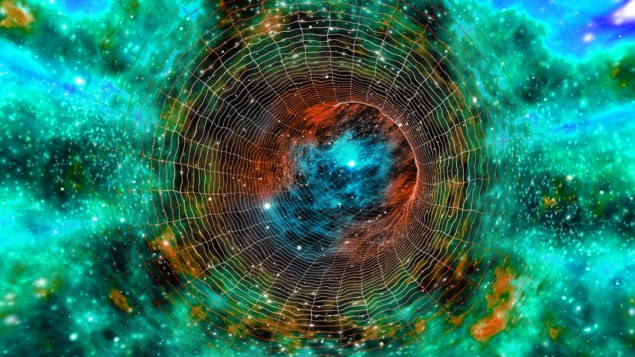Baffled by the big questions in science? String theorist Michael Dine thinks he has the answers
19 Dec 2022 Claire Malone
Claire Malone reviews This Way to the Universe: a Journey into Physics by Michael Dine
Cosmic journey Michael Dine takes you on a tour of some of the biggest questions in science such as the nature of dark matter. (Courtesy: iStock/3000ad)
We’ve all been there – scrolling through the latest physics books, hoping that something will stop us in our tracks, turn our understanding on its head or be a thoroughly entertaining read. But when I picked up This Way to the Universe: a Journey into Physics, it was more to keep pace with the art of describing the most baffling questions in physics, past and present, to a general audience. The book largely did what I had hoped for, but it offered so much more.
Written by Michael Dine – a theoretical physicist at the University of California, Santa Cruz – the book is divided into two broad themes. The first part surveys our current picture of fundamental physics, passing through Einstein’s relativity, detouring back through Newton for some context and then plunging into the highlights of quantum theory and nuclear physics.
Some readers will appreciate the impressively broad range of topics that Dine covers, though others may struggle with the lack of depth and background discussion given to each area. Still, the author does an expert job of linking the latest research questions to the history of science to emphasize the significance of the problems he describes, tackling topics such as matter–antimatter asymmetry, dark energy and string theory.
It is in the second half of the book, though, that the reader really gets some “added value” compared with similar titles. Here, Dine explains exactly where the frontiers of theoretical physics currently lie. The author even peers into the distant future, describing the gloomy “heat death” of the universe.
Dine’s text is rich with historical anecdotes, which bring to life the research being discussed. I have to admit, however, that anyone who is reasonably well-read in this field will probably be familiar with the author’s tales, such as the story of how the background static detected by the Holmdel Horn Antenna radio telescope was initially attributed to bird droppings rather than the cosmic microwave background.
But that quibble should not deter anyone familiar with the forefront of theoretical physics from reading This Way to the Universe. On the contrary, the book tackles several highly mathematical fields without resorting to any equations whatsoever – though it does mean the book will likely be impenetrable to anyone coming across such subjects for the first time.
Where the book really comes into its own, particularly for an undergraduate or a new graduate student, is the inside view it offers into the realities of physics research, especially those areas with a theoretical spin. Dine does this by supplementing the historical narrative with personal stories, such as the discussions physicists have when they drive to work together in a car pool – the conversation weaving between the latest departmental gossip and whose theoretical model has the most elegant features.READ MORE

Dine often adopts the tone of a wise university tutor, at one point even discouraging new graduate students from a career in theoretical physics given how hard it is to make a significant contribution to science. Indeed, the author says his proudest moment in science is when he discovered that a mechanism he once proposed was recorded as a footnote in the memoirs of the great Soviet physicist Andrei Sakharov.
Another refreshing thread that runs through the book is the attention given to the legacy of sexism and colonialism in the history of physics. He spotlights the research of both Marie Curie and Emmy Noether, citing a comment made by Albert Einstein in the New York Times, who said the latter was “the most significant creative mathematical genius thus far produced since the higher education of women began”. In fact, I appreciated how the author always refers to the hypothetical physics researcher with she/her pronouns.
An ideal primer for new graduate students who want to get a qualitative overview of the current state of fundamental physics
Dine also does a good job of emphasizing the co-operative nature of science, particularly when the discussion shifts to the more experimental aspects of particle physics, where collaborations can often involve thousands of people. In fact, I was uplifted by the author’s genuine interest in experimental research, despite him being a string theorist – and his ability to see and acknowledge the model’s flaws.
All of which makes This Way to the Universe an ideal primer for new graduate students who want to get a qualitative overview of the current state of fundamental physics, before delving into the more mathematical texts specific to their research. And even if you’re not an active physicist, the book will be perfect if you’re after some thought-provoking holiday reading. You will have your work cut out – but the view offered at the end will be well worth the mental effort.2022 Viking/Penguin 352pp £26.00hb / £9.97pb / 9.99ebook
physicsworld.com 29/12/2022

Δεν υπάρχουν σχόλια:
Δημοσίευση σχολίου